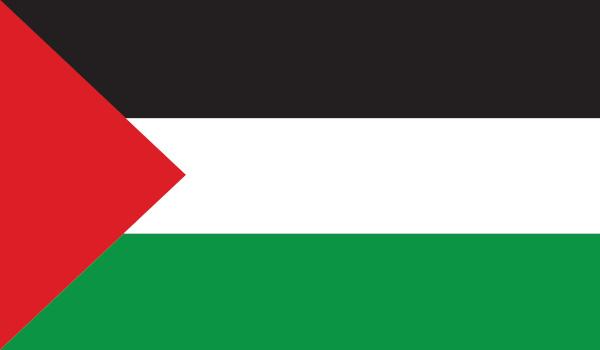THE Palestineis a non-continuous territory located in the Middle East region, covering the Gaza Strip and areas bordering the West Bank. Its recognition as a State is not unanimous among the UN countries, and the government of the territories is currently exercised through the Palestinian National Authority (PNA). The current Palestinian population settled in Gaza and the West Bank amounts to 5.1 million inhabitants.
Read too: Which countries in Asia?
Palestine general data
Region: Middle East.
Capital: East Jerusalem, as claimed by Palestine. Such status is disputed by Israel and also in the international community. The administrative headquarters of the Palestinian National Authority is located in Ramallah.
Government: parliamentary republic (provisional government).
Territorial area: 6,020 km² (UN, 2020).
Population: 5,154,173 inhabitants (Palestine Central Bureau of Statistics, 2020)¹.
Demographic density: 857 inhab./km².
Zone: GMT +2 hours (GMT+3 hours in summer time).
Climate: Mediterranean (Gaza) and tropical semiarid (West Bank).
Do not stop now... There's more after the advertising ;)
Palestine geography
Palestine is a region located in the Middle East. Your current territory has no contiguity physics, being divided between two distinct areas. The first one is the Gaza Strip, which has a surface area of approximately 365 km² and extends to the far east of the Mediterranean Sea, having land borders with Israel, east and north, and southwest with the Egypt.
The Palestinian territories are also located in the West Bank, located between Israel, which corresponds to the northern, southern and western borders, and the Jordan, to the east. Included in this region is the largest portion of the Dead Sea, on the southern border with Israeli lands.
Even within the limits of the West Bank, the areas corresponding to Palestine have no continuity, as can be seen from the map in the following section. Despite this, it is estimated that this has a total extension of 5,655 km², completing the 6,020 km² indicated by UN as being the Palestinian territory.
The weather types in Palestine are quite contrasting, which is due to its positioning. The Gaza Strip is under the direct influence of moisture from the Mediterranean Sea, while it is located in the vicinity of the desert south of Israel. In this region the temperate climate, with summers dry and hot and winters of mild and rainy temperatures.
In the West Bank, climatic conditions are influenced by both arid regions and altitude, which conditions different temperatures and water regimes. In general, summers are also dry and hot, while winters can be colder and have higher rainfall. Average temperatures in this region are 20.2º C, while rainfall accumulates 667 mm per year.
The territory of Palestine in Range Gaza is formed by plains, characterized by altitudes that do not exceed 105 meters above sea level, the altitude of its highest point.
within the limits of West Bank, in turn, the relief is formed by depressions and plateaus, that are concentrated from the center towards the west, having a mountain range, in the central portion of the territory, which extends from north to south. In this region, the presence of the Judean Desert, which covers the central lands and enters Israeli territory to the south, stands out.Altitudes are reduced in terrains near the Jordan River and the Dead Sea, where the rift valleys meet. Its highest point is on Mount Nabi Yunis, in the southwest region, at 1,030 meters.
Palestine Map

Palestine Demographics
Palestine currently has 5.154.173 population, according to official data for 2020. The largest portion of Palestinians (59.77%) live in the West Bank region, while the rest live in the administrative areas that make up the Gaza Strip, the equivalent of just over two million population. In this region, the population concentration is very high, of 5,693 inhabitants/km², being, therefore, the most populated. In other territories, the demographic density is smaller, with 545 inhab./km².
More than 738,000 Palestinians now live in other countries, disregarding the Arab countries, which, in turn, account for 6.14 million inhabitants coming from Palestine. The city of Hebron, which is divided between a portion belonging to Palestine and another under Israeli rule, is the most populous in the West Bank, with 27,161 inhabitants. In the Gaza Strip, most Palestinians live in Gaza City, which has 21,831 inhabitants.
According to the United Nations Development Program, O HDI of Palestine is 0.708, value considered high. Life expectancy in that territory is 74.1 years, while the number of illiterates was 2.5% of the population over 15 years of age in 2020. Both data are used to compose the indicator.
See too: What is the difference between Arabs and Muslims?
Geographical division of Palestine
Palestinian territories are divided by the Palestinian National Authority into administrative areas or cities. There are 16 in total: 5 in the Gaza Strip and 11 in the West Bank, as listed below.
-
Gaza Strip:
North Gaza;
Gaza;
Deir al-Ballah;
Khan Yunis;
Rafah.
-
West Bank:
Hebron;
Jerusalem;
Jericho;
Bethlehem;
Jenin;
Nablus;
Calkylia;
Ramallah;
Salfit;
Tubas;
Tucarem.
Palestine Economy
Due to the unstable political situation and frequent conflicts, the economy of the Palestinian territories, especially their agricultural production and industrial development, is facing many limitations. UN data for the year 2020 show a Gross Domestic Product (GDP) in the amount of US$ 16.27 billion, a figure that has increased by approximately 68% in a decade. The GDP per capita, in turn, is US$ 3,347 for the same period.
THE agriculture is considered one of the pillarsare you of the Palestinian economy, still representing a good part of the jobs in the territories. Its production takes place mainly through irrigation in drier regions and depends on the rainy season in areas where rainfall is higher. Fruit trees, with great emphasis on olive trees, vegetables, vegetables and citrus fruits, are the main crops. The fishing activity, in turn, has great relevance for the economy of the Gaza Strip, with an outlet to the Mediterranean.
In the industry, the technology and communication sector has gained strength in recent years, with a large presence of startups. The production derived from the primary sector, such as the processing of olives and the production of food and beverages, wood and cellulose, as well as essential services (production of energy, water) and manufactures, such as the production of chemical, pharmaceutical, medical and hospital products, vehicles, among others.At the tertiary sector, tourism, mainly religious, is one of the main economic activities.
One of the economic problems facing the Palestinian territories today is the unemployment, much higher in the Gaza Strip, which was 49.1% in 2020. This value drops considerably in the West Bank, which has a rate of 14.8%.
Palestinian government
Palestine is not officially recognized as a state by all nations across the globe, having no permanent governmental structure. Its current form of government is parliamentarism, composed of the president and the prime minister. The Palestinian provisional government is represented by the Palestinian National Authority (ANP), established in 1994. Its headquarters are in the city of Ramallah, although East Jerusalem is claimed as the capital of Palestine.
Until 2019, Palestine was recognized by 138 of the member countries of the United Nations, including Brazil.
Read too: Government regimes - how the government behaves in power
flag of palestine

Palestine Infrastructure
The Palestinian territories have a mostly urban population. According to official data, almost all homes are served by the treatment networks of sewage, which cover 98.8% of all Palestinian households, which includes the Gaza Strip and the West Bank. Drinking water, in turn, reaches 99.8% of homes in this region.
The data, however, refer only to homes connected to the urban network, since the UN information indicates that the population with access to adequate sewage treatment is smaller, than 64,7%.
The population with access to electricity reached 99.8% in 2019, according to official information. THE Palestine's energy matrix is formed by renewable sources and fossil fuels and, in addition, that territory has a portion of energy imported from other regions. It is also noteworthy that the population with access to the Internet has almost doubled in ten years, reaching 64.4% of Palestinians in 2020, according to the UN.
culture of palestine
Palestinian culture was built over the centuries and has the Arab, Armenian, Greek, European, Turkish, Hebrew and other influences, in addition to representing an aspect of identity and union of its population, which is quite divided, not only in the Middle East, but in other parts of the planet as a refugees.
Religion is of great importance to Palestinians, especially Christianity, Islam and also Judaism. The family structure is fundamental in the culture and among the important celebrations are weddings, commonly arranged by family members and whose feasts last for days. at the other extreme, funeral rites also tend to last 40 days, and the houses are open for three days so that the family can receive condolences. Black coffee (without sugar) is one of the drinks consumed on these occasions.
Among the important holidays for Palestinians, Palestine Independence Day and the International Day of Solidarity with the Palestinian People stand out. Crafts and music are important forms of cultural expression, as well as traditional costumes and the keffiyeh, checkered pattern scarf that has become a symbol of that territory. In dance, the highlight is the dabke. Finally, Palestinian cuisine is represented by dishes such as maqluba, humus and knafeh (sweet made with fine noodles), in addition to olive oil.
history of palestine
The occupation of the Middle East and the areas where the Palestinian territories are located date back to the ancient Stone Age. With time, several peoples settled in that area, which went through the domain of the Egyptians, Israelites, Assyrians, Babylonians - period in which the expulsion of the Jews from the region occurred - Persians and also of the Roman Empire.
During Rome's rule over those lands, the Jewish people were once again expelled, which occurred around 70 AD. Under the domain of iEmperor Hadrian, the place was named Palestine, a name that makes direct reference to the Philistine people, who lived and disputed those lands with the Jews.
Arab Muslim rule in the region began in 636 and remained until the beginning of the 20th century, passing through a period of time under the Ottoman Empire. It coincides with the end of Arab domination in the Palestinian territory o emergence of Zionist movement, in the late nineteenth century, which had as its main objective the return of the Jews to the Promised Land and the creation of a state.
the end of First World War, in 1918, marked the advance of England in that area. Jews began their return movement during this same period, while Palestinians protested their arrival. There was, from the Second World War (1939-1945), the intensification of the return migration flow of the Jewish people and, with that, increased tensions with the Palestinians.
The partition of Palestine was made official in the year 1947 by the United Nations (UN) and, ua year later, he gave up creation of the State of Israel. As a result of the division, the largest portion of land remained with the Jews, which was not accepted by the Arab peoples, who were assigned around 45% of the territory. One of the consequences of this process was the First Arab-Israeli War (1948-1949). Israeli territory continued to expand over time, while, as we could see in the presented maps, the area destined to the Palestinians was gradually shrinking.
![The Palestinians are still fighting for the creation of their own state. [1]](/f/d658e1cba555cb5513db0a4390383d5c.jpg)
THE Palestine Liberation Organization (PLO) was created in 1964 in defense of the rights of the Palestinian people by securing their territory, starting to demand the creation of a State of Palestine. The group is officially recognized by the United Nations.
In the 1990s, through the Oslo Agreement, the territorial domain of some areas was guaranteed to Palestine, but not the creation of a national state. As a result, the provisional government of the Palestinian National Authority (ANP) was created. Conflicts with Israelis have not ceased, the most recent of which occurred in May 2021. Palestinians continue their struggle for recognition of their state and greater political autonomy.
Note
Data referring to the Palestinian population and economy, unless otherwise indicated, were taken from the website of the Palestine Central Bureau of Statistics, an official source for the Palestinian National Authority.
Image credit
[1] Chameleons Eye / Shutterstock
By Paloma Guitarrara
Geography teacher



